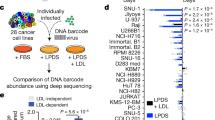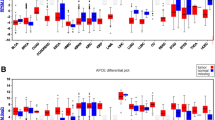Abstract
Tumour are characterised by a high content of cholesteryl esters (CEs) stored in lipid droplets purported to be due to a high rate of intracellular esterification of cholesterol. To verify whether and which pathways involved in CE accumulation are essential in tumour proliferation, the effect of CE deprivation, from both exogenous and endogenous sources, on CEM-CCRF cells was investigated. Cholesterol synthesis, esterification and content, low-density lipoprotein (LDL) binding and high-density lipoprotein (HDL)-CE uptake were evaluated in cultured in both conventional and delipidated bovine serum with or without oleic or linoleic acids, cholesteryl oleate, LDL and HDL. High content of CEs in lipid droplets in this cell line was due to esterification of both newly synthesised cholesterol and that obtained from hydrolysis of LDL; moreover, a significant amount of CE was derived from HDL-CE uptake. Cell proliferation was slightly affected by either acute or chronic treatment up to 400 μM with Sz-58035, an acyl-cholesteryl cholesterol esterification inhibitor (ACAT); although when the enzyme activity was continuously inhibited, CE content in lipid droplets was significantly higher than those in control cells. In these cells, analysis of intracellular and medium CEs revealed a profile reflecting the characteristics of bovine serum, suggesting a plasma origin of CE molecules. Cell proliferation arrest in delipidated medium was almost completely prevented in the first 72 h by LDL or HDL, although in subsequent cultures with LDL, it manifested an increasing mortality rate. This study suggests that high content of CEs in CEM-CCRF is mainly derived from plasma lipoproteins and that part of CEs stored in lipid droplets are obtained after being taken up from HDL. This route appears to be up-regulated according to cell requirements and involved in low levels of c-HDL during cancer. Moreover, the dependence of tumour cells on a source of lipoprotein provides a novel impetus in developing therapeutic strategies for use in the treatment of some tumours.






Similar content being viewed by others
References
Batetta B, Sanna F. Cholesterol metabolism during cell growth: which role for the plasmamembrane? Eur J Lpid Sci Tecnol. 2006;108:687–99.
Dessì S, Batetta B. Cholesterol metabolism in human tumors. In: Pani A, Dessì S, editors. Cell growth and cholesterol esters. New York: Kluwer; 2004; p. 35–47.
Tosi MR. Cholesteryl esters in malignancy. Clin Chim Acta. 2005;359:27–45.
Ginsberg HN, Le NA, Gilbert HS. Altered high density lipoprotein metabolism in patients with mieloproliferative disorders and hypocholesterolemia. Metabolism. 1986;35:878–82.
Dessì S, Batetta B, Spano O, Sanna F, Tonello M, Giacchino M, Madon E, Pani P. Clinical remissions associate with restoration of normal high density lipoprotein cholesterol levels in children with malignancies. Clin Sci. 1995;89:505–10.
Halton JM, Nazir DJ, McQeen MJ, Ban RD. Blood lipid profiles in children with acute lymphoblastic leukemia. Cancer. 1998;83:379–84.
Dessì S, Batetta B, Pulisci D, Spano O, Anchisi C, Tessitore L, Costelli P, Baccino FM, Aroasio E, Pani P. Cholesterol content in tumor tissues is inversely associated with high density lipoprotein cholesterol in serum in patients with gastrointestinal cancer. Cancer. 1994;15:253–58.
Anchisi C, Batetta B, Sanna F, Fadda AM, Maccioni AM, Dessì S. HDL sub-fractions as altered in cancer patients. J Pharm Biomed Anal. 1995;13:85–71.
Suckling KE, Stange EF. Role of acyl-CoA cholesterol acyltransferase in cellular cholesterol metabolism. J Lipid Res. 1985;26:647–71.
Chang TY, Li BL, Chang CC, Urano Y. Acyl-coenzyme A:cholesterol acyltransferases. Am J Physiol Endocrinol Metab. 2009;297:E1–9.
Ghosh S, Zhao B, Bie J, Song J. Macrophage cholesteryl ester mobilization and atherosclerosis. Vascul Pharmacol. 2010;52:1–10.
Gebhard RL, Clayman RV, Prigge MF, Figenshau R, Stanley NA, Reesey, Bear A. Abnormal cholesterol metabolism in renal clear carcinoma. J Lipid Res. 1987;28:1177–84.
Righi V, Mucci A, Schenetti L, Tosi MR, Grigioni WF, Corti B, Bertaccini A, Franceschelli A, Sanguedolce F, Schiavina R, Martorana G, Tugnoli V. Ex vivo HR-MAS magnetic resonance spectroscopy of normal and malignant human renal tissues. Anticancer Res. 2007;27:3195–204.
Tugnoli V, Poerio A, Tosi MR. Phosphatidylcholine and cholesteryl esters identify the infiltrating behaviour of a clear cell renal carcinoma: 1H, 13 C and 31P MRS evidence. Oncol Rep. 2004;12:353–256.
Dessì S, Batetta B, Anchisi C, Pani P, Costelli P, Tessitore L, Baccino FM. Cholesterol metabolism during the growth of a rat ascites hepatoma (Yoshida AH-130). Br J Cancer. 1992;66:787–93.
Rao KM, Kottapally S, Eskander ED, Shinozuka H, Dessì S, Pani P. Acinar cell carcinoma of rat pancreas: regulation of cholesterol esterification. Br J Cancer. 1986;54:305–10.
Dessì S, Batetta B, Pani A, Spano O, Sanna F, Putzolu M, Bonatesta R, Piras S, Pani P. Role of cholesterol synthesis and esterification in the growth of CEM and MOLT4 lymphoblastic cells. Biochem J. 1997;321:603–8.
Oram JF, Mendez AJ, Lymp J, Kavanagh TJ, Halbert CL. Reduction in apolipoprotein-mediated removal of cellular lipids by immortalisation of human fibroblasts and its reversion by cAMP: Lack of effect with Tangier diseases cells. J Lipid Res. 1999;40:1769–81.
Batetta B, Pani A, Putzolu M, Sanna F, Bonatesta RR, Piras S, Spano O, Mulas MF, Dessí S. Correlation between cholesterol esterification, NDR1 gene expression and rate of cell proliferation in CEM and MOLT lymphoblastic cell lines. Cell Prolif. 1999;32:49–61.
Batetta B, Mulas MF, Sanna F, Putzolu M, Bonatesta RR, Gasperi-Campani A, Roncuzzi D, Baiocchi, Dessì S. Dual role of cholesteryl ester pathway in the control of cell cycle in human aortic smooth muscle cells. FASEB. 2003;17:746–48.
Peiretti E, Dessì S, Mulas C, Abete C, Norfo C, Putzolu M, Fossarello M. Modulation of cholesterol homeostasis by antiproliferative drugs in human pterygium fibroblasts. Invest Ophthalmol Vis Sci. 2007;48:3450–58.
Bemlih S, Poirier MD, El AA. Acyl-coenzyme A: cholesterol acyltransferase inhibitor Avasimibe affect survival and proliferation of glioma tumor cell lines. Cancer Biol Ther. 2010;19:1025–32.
Paillasse MR, De Medina P, Amouroux G, Mhandi L, Poirot M, Silvente-Poirot S. Signalling through cholesterol esterification: a new pathway for the cholecystokinin 2 receptor involved in cell growth and invasion. J Lipid Res. 2009;50:2203–11.
Sainte-Marie J, Vidal M, Sune A, Ravel S, Philippot JR, Bienveniie A. Modifications of LDL-receptor-mediated endocytosis rates in CEM lymphoblastic cells grown in lipoprotein-depleted fetal calf serum. Biochim Biophis Acta. 1989;982:265–70.
Murao K, Imachi H, Cao W, Yu X, Li J, Yoshida K, Ahmed RA, Matsumoto K, Nishiuchi T, Wong NC, Ishida T. High-density lipoprotein is a potential growth factor for adrenocortical cells. Biochem Biophys Res Commun. 2006;344:226–32.
Bradford MM. A rapid and sensitive method for the quantization of microgram quantities of protein utilizing the principle of protein-dye binding. Anal Biochem. 1976;72:248–54.
Folch J, Lees M, Loane-stanley GH. A simple method for the isolation and purification of total lipids from animal tissues. J Biol Chem. 1953;222:497.
Cullen P, Fobker M, Tegelkamp K, Meyer K, Kannenberg F, Cignarella A, Benninghoven A, Assmann G. An improved method for quantification of cholesterol and cholesteryl esters in human monocyte-derived macrophages by high performance liquid chromatography with identification of unassigned cholesteryl ester species by means of secondary ion mass spectrometry. J Lipid Res. 1997;38:401–9.
Angioni E, Lercker G, Frega NG, Carta G, Melis MP, Murru E, Spada S, Banni S. UV spectral properties of lipids as a tool for their identification. Eur J Lipid Sci Technol. 2002;104:59–64.
Banni S, Carta G, Contini MS, Angioni E, Deiana M, Dessì MA, Melis MP, Corongiu FP. Characterization of conjugated diene fatty acids in milk, dairy products and lamb tissues. J Nutritional Biochem. 1996;7:150–55.
Greenspan P, Fowler SD. Spectrofluorometric studies of the lipid probe Nile Red. J Lipid Res. 1985;26:781–89.
Diaz G, Batetta B, Sanna F, Uda S, Reali C, Angius F, Melis M, Falchi AM. Lipid droplet changes in proliferating and quiescent 3 T3 fibroblasts. Histochem Cell Biol. 2008;129:611–21.
Stephan ZF, Yurachek EC. Rapid fluorometric assay of LDL receptor activity by DiI-labeled LDL. J Lipid Res. 1993;34:325–30.
Buttke TM, Van Cleaves S. Adaptation of a cholesterol deficient human T cell line to growth with lanosterol. Biochem Biophis Res Commun. 1994;200:206–12.
Neverov NI, Kavsen GA, Nuccitelli R, Weiss RH. HDL causes mesangial cell mitogenesis through a tyrosine kinase-dependent receptor mechanism. J Am Soc Nephrol. 1997;8:1247–56.
Nofer JR, Junker R, Pulawski E, Fobker M, Levkau B, Von Eckardstein A. High density lipoproteins induce cell cycle entry in vascular smooth muscle cells via mitogen activated protein kinase-dependent pathway. Thromb Haemost. 2001;85:730–35.
Jurgens J, Xu Q, Huber LA, Bock G, Howanietz H, Wick G, Traill KN. Promotion of lymphocyte growth by high density lipoprotein (HDL). Physiological significance of the HDL binding site. J Biol Chem. 1989;264:8549–56.
Vitols S, Gunven P, Gruber A, Larsson O. Expression of the low density lipoprotein and multidrug resistance (Mdr-1) genes in colorectal carcinomas. Biochem Pharmacol. 1996;52:127–31.
Pagler TA, Golsabahi S, Doringer M, Rhode S, Schultz GJ, Pavelka M, Eckhardt ER, van der Westhuyzen DR, Schütz GJ, Stangl H. A Chinese hamster ovarian cell line import cholesterol by high density lipoprotein degradation. J Biol Chem. 2006;281:38159–71.
Pussinen PJ, Karten B, Wintersperger A, Reicher H, Mclean M, Malle E, Sattler W. The human breast carcinoma cell line HBL-100 acquires exogenous cholesterol from high-density lipoprotein via CLA-1 (CD-36 and LIMPII analogous 1)- mediated selective cholesteryl ester uptake. Biochem J. 2000;349:559–66.
Wadsack C, Hirschmugl B, Hammer A, Levak-Frank S, Kozarsky KF, Sattler W, Malle E. Scavenger receptor class B, type 1 on non-malignant and malignat human epithelial cells mediates cholesteryl ester-uptake from high density lipoproteins. Inter J Biochem Cell Biol. 2003;35:441–54.
Swinnen JV, Van Veldhoven P, Esquenet M, Heyns W, Verhoeven G. Androgens markedly stimulate the accumulation of neutral lipids in the human prostatic adenocarcinoma cell line LNCaP. Endocrinology. 1996;137:4468–74.
Gonçalves RP, Rodrigues DG, Maranhão RC. Uptake of high density lipoprotein (HDL) cholesteryl esters by human acute leukemia cells. Lek Res. 2005;29:955–59.
Walter M, Reinecke H, Nofer JR, Seedorf U, Assman G. HDL3 stimulates multiple signaling pathways in human skin fibroblasts. Atherosc Thromb Vasc Biol. 1995;15:1975–86.
Nofer JR, Fobker M, Hobbel G, Voss R, Wolinska I, Tepel M, Zidek W, Junker R, Seedorf U, von Eckardstein A, Assmann G, Walter M. Activation of phosphatidylinositol-specific phospholipase C by HDL-associated lysosphingolipid. Involvement in mitogenesis but not in cholesterol efflux. Biochemistry. 2000;39:15199–207.
Kimura T, Sano K, Malchinskuu E, Tomura K, Tamama K, Kuwabara MM, Okajima F. High density lipoprotein stimulates endothelial cell migration and survival through sphingosine-1-phosphate and its receptors. Atheroscl Thromb Vasc Biol. 2003;23:1283–88.
Hoekstra M, Ye D, Hildebrand RB, Zhao Y, Lammers B, Stitzinger M, Kuiper J, Van Berkel TJ, Van Eck M. Scavenger receptor class B type I-mediated uptake of serum cholesterol is essential for optimal adrenal glucocorticoid production. J Lipid Res. 2009;50:1039–46.
Acknowledgements
The authors thank Ms. Anne Farmer for editing of the English language and Mrs. Anna Saba for technical assistance. The study was funded by Fondazione Banco di Sardegna, Regione Autonoma della Sardegna, PRIN 2008 and Nutrisearch Srl (Italy).
Author information
Authors and Affiliations
Corresponding author
Rights and permissions
About this article
Cite this article
Uda, S., Accossu, S., Spolitu, S. et al. A lipoprotein source of cholesteryl esters is essential for proliferation of CEM-CCRF lymphoblastic cell line. Tumor Biol. 33, 443–453 (2012). https://doi.org/10.1007/s13277-011-0270-6
Received:
Accepted:
Published:
Issue Date:
DOI: https://doi.org/10.1007/s13277-011-0270-6




